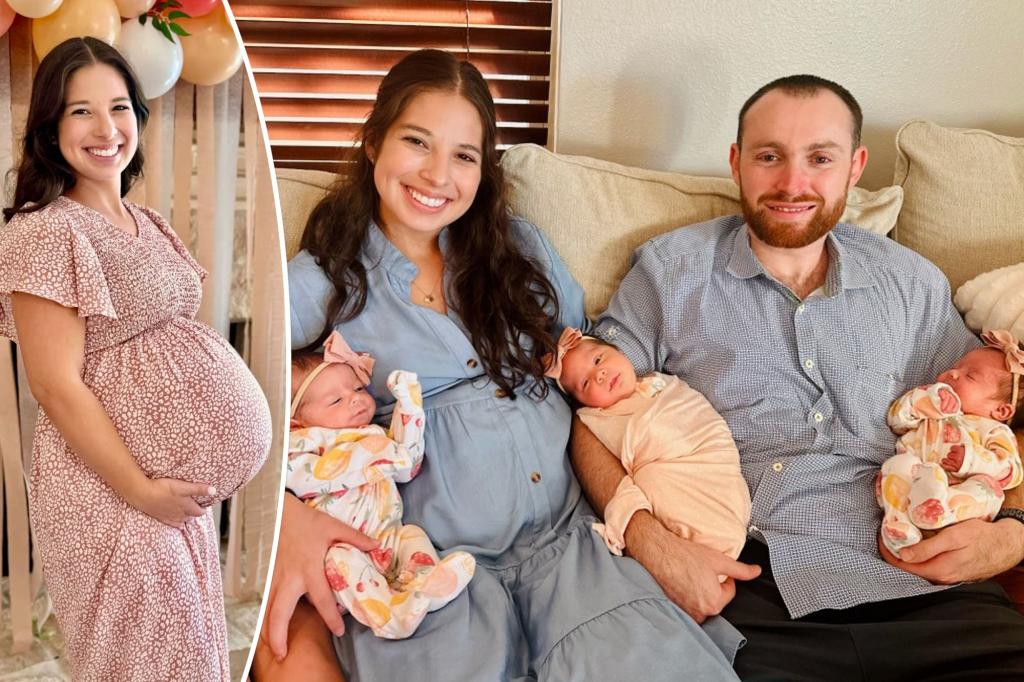A Texas mother was “clinically dead” for 45 minutes after successfully delivering triplets during a planned C-section following a “catastrophic” medical occurrence that usually’s “about 80%, 85% fatal.”
Marisa Christie, 30, and her husband, Dylan, were excited but nervous when doctors told them during her first ultrasound for her second pregnancy that she appeared to be carrying triplets, she told TODAY.com.
“They were like, ‘We’re pretty sure it’s twins. There might be a third one hiding,’” she told the outlet. “I was in complete shock.”
Christie, 33 weeks pregnant, arrived for her scheduled C-section at Memorial Hermann The Woodlands Medical Center North of Houston on Aug. 21.
Her babies were successfully delivered by her maternal-fetal medicine physician, Dr. Amber Samuel, and were resting on top of her when things took an abrupt turn for the worse. Christie had begun seizing.
“My arms flew up, and that was when my heart stopped,” she told the outlet.
The anesthesiologist for the c-section, Dr. Ricardo Mora, realized “She (was) essentially gray” and said he “knew something terrible just occurred.”
Mora, who said he was the anesthesiologist during a delivery where a mom experienced similar symptoms 15 years ago, immediately knew Christie was experiencing an amniotic fluid embolism (AFE) — a rare but often fatal birth complication.
“It’s pretty catastrophic. When it occurs, it’s about 80%, 85% fatal,” Mora told the outlet.
“I asked Dr. Samuel what she had done. She related to me that she had just started pulling the placenta out and that’s usually the time when this occurs — the separation of the placenta and uterus.”
Mora said he immediately called a code blue — a hospital emergency code indicating a patient is in critical condition — knowing they’d need all the help they could get during the dire situation.
“She wasn’t breathing,” Mora explained. “We started CPR because she had no pulse.”
Christie was hemorrhaging as they performed CPR. It got so intense that doctors kept replacing her blood while Samuel tried to stop the bleeding by closing her uterus.
As they worked tirelessly to keep the mother alive, Dr. Stephen Maniscalco, a cardiothoracic and vascular surgeon at the hospital, prepared to place Christie on ECMO — a machine that works for the heart and lungs to help the body recover.
Nearly an hour after Christie’s heart stopped, the ECMO was pumping blood into her as she lay unconscious.
“She essentially lost what we consider her whole blood volume,” Mora shared.
“We replaced her blood volume. So, for 45 minutes, she was clinically dead.”
The doctors were able to stabilize her with the ECMO, but she again began bleeding and needed to be rushed into an operating room for emergency surgery.
“Anything that can bleed will because you don’t have the normal clotting factors,” Samuel told TODAY.com.
Despite using various medications and devices to stop her uterus from bleeding, nothing seemed to be working.
“We tried to resuscitate her and prevent her from having a hysterectomy,” Samuel explained.
“Cutting into (her) was very, very dangerous.”
Finally, doctors were left with no other option but to remove Christie’s uterus.
“There are lots of little, tiny blood vessels that, in normal circumstances, will just clot up and stop bleeding on their own,” Samuel shared.
However, Samuel said since she was experiencing amniotic fluid embolism, “if you close that up, what happens inevitably is that (blood vessels) dump a bunch of blood in that space, and it causes it to re-open.”
An amniotic fluid embolism occurs when some fetal substance crosses from the baby’s circulation to the mother’s circulation but is considered a “very rare occurrence,” the maternal-fetal medicine physician told the outlet.
“It’s a little bit like getting struck by lightning,” Samuel said.
“Every organ system is failing immediately, so you need people to take care of every organ system.”
Samuel said that having “access to blood products and ECMO, which is what Marisa went on, are vital to surviving.”
Though uncommon, an amniotic fluid embolism is considered a potentially fatal medical emergency, with many hospitals trained to take action if it should occur.
Following the near-fatal medical emergency, Christie remained unconscious and on ECMO for a week while doctors monitored her, hoping they did enough to save her.
“You can do the best CPR in the world, but if you don’t get enough blood to the brain, essentially they are alive but with brain damage,” Mora told the outlet.
Fortunately, doctors soon noticed she fluttered her eyes and seemed to hear people talking around her —a beacon of hope that the mother would pull through.
Then, her condition improved enough that she was weaned off the breathing machine and ECMO.
“Essentially, she got stronger and stronger,” Mora said.
Eventually, Christie was fully conscious but felt confused and thought she was experiencing the vivid dreams she had throughout pregnancy.
She was told that her triplets, three girls named Charlotte, Kendall, and Collins, were “completely healthy.”
However, the mother said it felt “very surreal.”
“I remember thinking, ‘I don’t know these babies. This is very strange. They feel like they’re not real. They feel like they’re not mine,’” she told TODAY.com.
“They were already over a week old by the time I had met them. … It took a little bit to get that connection with them.”
But that “strange” feeling quickly faded after Christie realized the newborns “could tell that I was their mom.”
“They respond to me when I talk to them as opposed to other people,” she said.
Christie explained she decided to share her story to raise awareness of amniotic fluid embolism and offer others hope if they or a loved one encounter a similar occurrence.
“It’s rare, but it does happen,” she said. “There were so many miracles that led up to me living instead of dying and we’re grateful.”
Read the full article here

